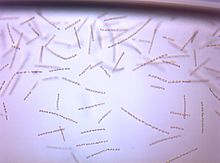
A diatom is any member of a large group comprising several genera of algae, specifically microalgae, found in the oceans, waterways and soils of the world. Living diatoms make up a significant portion of the Earth's biomass: they generate about 20 to 50 percent of the oxygen produced on the planet each year, take in over 6.7 billion tonnes of silicon each year from the waters in which they live, and constitute nearly half of the organic material found in the oceans. The shells of dead diatoms can reach as much as a half-mile deep on the ocean floor, and the entire Amazon basin is fertilized annually by 27 million tons of diatom shell dust transported by transatlantic winds from the African Sahara, much of it from the Bodélé Depression, which was once made up of a system of fresh-water lakes.
In biology, setae are any of a number of different bristle- or hair-like structures on living organisms.
A resting spore is a resistant cell, used to survive adverse environmental conditions. Resting spore is a term commonly applied to both diatoms and fungi.
Auxospores are specialised cells in diatoms that are produced at key stages in their cell cycle or life history. Auxospores typically play a role in growth processes, sexual reproduction or dormancy.

Thalassiosira pseudonana is a species of marine centric diatoms. It was chosen as the first eukaryotic marine phytoplankton for whole genome sequencing. T. pseudonana was selected for this study because it is a model for diatom physiology studies, belongs to a genus widely distributed throughout the world's oceans, and has a relatively small genome at 34 mega base pairs. Scientists are researching on diatom light absorption, using the marine diatom of Thalassiosira. The diatom requires a high enough concentration of CO2 in order to utilize C4 metabolism (Clement et al. 2015).

Marnaviridae is a family of positive-stranded RNA viruses in the order Picornavirales that infect various photosynthetic marine protists. Members of the family have non-enveloped, icosahedral capsids. Replication occurs in the cytoplasm and causes lysis of the host cell. The first species of this family that was isolated is Heterosigma akashiwo RNA virus (HaRNAV) in the genus Marnavirus, which infects the toxic bloom-forming Raphidophyte alga, Heterosigma akashiwo. As of 2021, there are twenty species across seven genera in this family, as well as many other related virus sequences discovered through metagenomic sequencing that are currently unclassified.
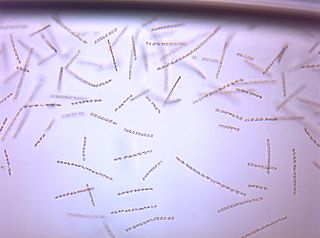
Chaetocerotaceae is a diatom family. Chaetoceros is perhaps the largest and most species rich genus of marine planktonic diatoms. The taxonomic status within Chaetocerotaceae at present is somewhat unclear.

Chaetoceros is a genus of diatoms in the family Chaetocerotaceae, first described by the German naturalist C. G. Ehrenberg in 1844. Species of this genus are mostly found in marine habitats, but a few species exist in freshwater. It is arguably the common and most diverse genus of marine planktonic diatoms, with over 200 accepted species. It is the type genus of its family.
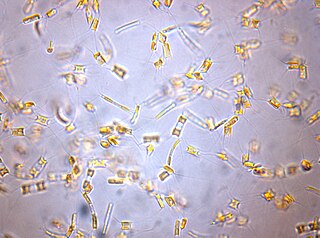
Attheya is a genus of small single celled diatoms. Some of these species were earlier regarded to belong to Chaetoceros, or to Gonioceros, the taxonomic status of some of these species are still debated.

Bacteriastrum is a genus of diatoms in family Chaetocerotaceae. There are more than 30 described species in genus Bacteriastrum, but many of these are not currently accepted, and new species are still added to the genus. The type species for the genus is Bacteriastrum furcatum Shadbolt.

Chaetoceros diadema is a diatom in the genus Chaetoceros. The easiest way to identify this species is by finding the very characteristic diadem-like resting spores.
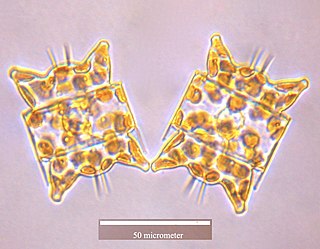
Odontella aurita is a diatom and the type species of genus Odontella. The easiest way to identify this species is by recognizing the very distinct shape of the cells belonging to this genus. Odontella aurita is cultivated industrially for human consumption due to its ability to produce up to 28% of its total lipids as eicosapentaenoic acid (EPA), a long-chain polyunsaturated fatty acid (PUFA). PUFAs such as EPA are known to provide a variety of health benefits in humans, and are commonly obtained by fish oil. However, with the increasing concern of over-exploited fisheries, microalgae are a promising source of PUFAs as they can be grown year-round and their fatty acid profile and content are easily manipulated by growth conditions.
Chaetoceros pseudocurvisetus is a marine diatom in the genus Chaetoceros. It is an important primary producer in the oceans. C. pseudocurvisetus forms resting spores and resting cells, particularly in the absence of essential nutrients.
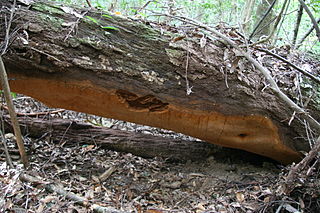
Phellinus ellipsoideus is a species of polypore fungus in the family Hymenochaetaceae, a specimen of which produced the largest fungal fruit body ever recorded. Found in China, the fruit bodies produced by the species are brown, woody basidiocarps that grow on dead wood, where the fungus feeds as a saprotroph. The basidiocarps are perennial, allowing them to grow very large under favourable circumstances. They are resupinate, measuring 30 centimetres (12 in) or more in length, though typically extending less than a centimetre from the surface of the wood. P. ellipsoideus produces distinct ellipsoidal spores, after which it is named, and unusual setae. These two features allow it to be readily differentiated microscopically from other, similar species. Chemical compounds isolated from the species include several steroidal compounds. These may have pharmacological applications, but further research is needed.

Parasola auricoma is a species of agaric fungus in the family Psathyrellaceae. First described scientifically in 1886, the species is found in Europe, Japan, and North America. The mushroom was reported in February 2019 in Colombia, in the city of Bogota by the mycologist Juan Camilo Rodriguez Martinez. The small, umbrella-shaped fruit bodies (mushrooms) of the fungus grow in grass or woodchips and are short-lived, usually collapsing with age in a few hours. The caps are up to 6 cm (2.4 in) wide, initially elliptical before flattening out, and colored reddish-brown to greyish, depending on their age and hydration. They are pleated with radial grooves extending from the center to the edge of the cap. The slender, whitish stems are up to 12 cm (4.7 in) long and a few millimeters thick. Microscopically, P. auricoma is characterized by the presence of setae in its cap cuticle. This characteristic, in addition to the relatively large, ellipsoid spores can be used to distinguish it from other morphologically similar Parasola species.
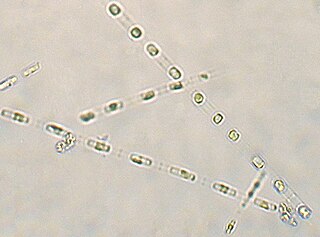
Skeletonema is a genus of diatoms in the family Skeletonemataceae. It is the type genus of its family. The genus Skeletonema was established by R. K. Greville in 1865 for a single species, S. barbadense, found in the Barbados deposit [Jung 2009]. These diatoms are photosynthetic organisms, meaning they obtain carbon dioxide from their surrounding environment and produce oxygen along with other byproducts. Reproduce sexually and asexually [Guiry 2011]. Skeletonema belong to the morphological category referred to as centric diatoms. These are classified by having valves with radial symmetry and the cells lack significant motility [Horner 2002]. Skeletonema are cylindrical shaped with a silica frustule. Cells are joined by long marginal processes to form a filament [Horner 2002]. Their length ranges from 2-61 micrometers, with a diameter ranging from 2-21 micrometers [Hasle 1997]. They are found typically in the neritic zone of the ocean and are highly populous in coastal systems [Jung 2009]. The genus is considered cosmopolitan, showing a wide range of tolerance for salinity and temperature [Hasle 1973]. For example, they have been found in various aquatic environments such as brackish or freshwater. Skeletonema are found worldwide excluding Antarctic waters [Hevia-Orube 2016]. Some harmful effects these diatoms may have on an ecosystem are attributed to large blooming events which may cause hypoxic events in coastal systems. Additionally, they are known to cause water discoloration [Kraberg 2010].
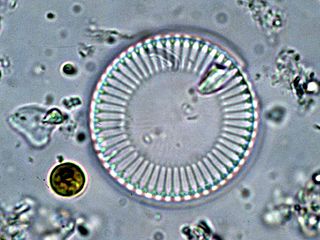
Cyclotella is a genus of diatoms often found in oligotrophic environments, both marine and fresh water. It is in the family Stephanodiscaceae and the order Thalassiosirales. The genus was first discovered in the mid-1800s and since then has become an umbrella genus for nearly 100 different species, the most well-studied and the best known being Cyclotella meneghiniana. Despite being among the most dominant genera in low-productivity environments, it is relatively understudied.
Chaetoceros coarctatus is a marine, unicellular species of planktonic diatom in the genus Chaetoceros, first described by Lauder in January 1864 using samples from the Hong Kong harbor. Like many diatoms, it is preyed upon by ctenophores. During warming periods of the Mediterranean Sea, this non-native species, first introduced through the Suez Canal, expands its range. Cell chains showcase pairs of posterior and anterior terminal setae, as well as intercalary setae, for anti-predatory mechanical protection and floating benefits. These silica appendages have spines, curved tips, and are longer those on other members of the Chaetoceros genus for higher survival benefits.
Richelia is a genus of nitrogen-fixing, filamentous, heterocystous and cyanobacteria. It contains the single species Richelia intracellularis. They exist as both free-living organisms as well as symbionts within potentially up to 13 diatoms distributed throughout the global ocean. As a symbiont, Richelia can associate epiphytically and as endosymbionts within the periplasmic space between the cell membrane and cell wall of diatoms.

Leptocylindrus is a genus of diatoms belonging to the family Leptocylindraceae. They are long, cylindrical diatoms that are made up of multiple cells in a line. These cells have chloroplast to allow it to produce energy through photosynthesis by taking in sunlight and carbon dioxide to create sugars. the cells are attached at the cell walls called valves, the cell wall is slightly concave on one side and convex on the other so that the other cell wall attached will fit together.
